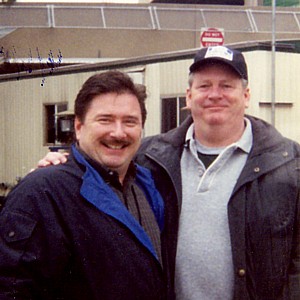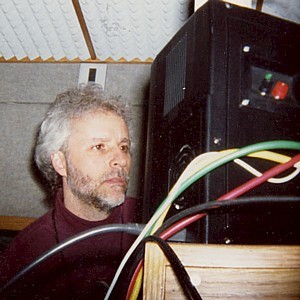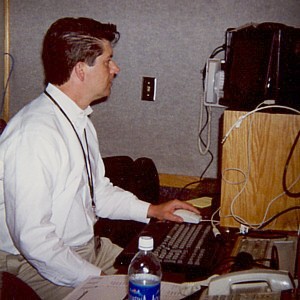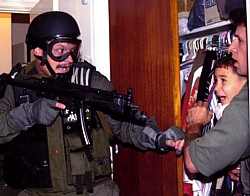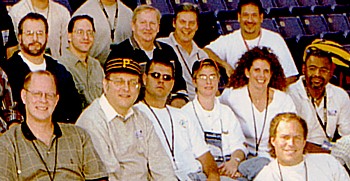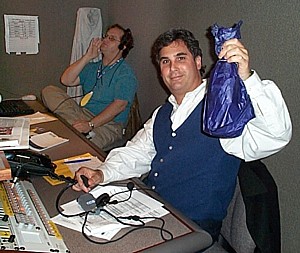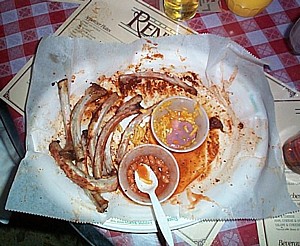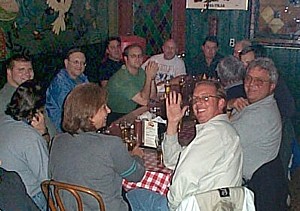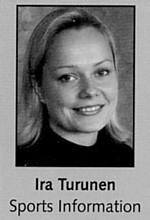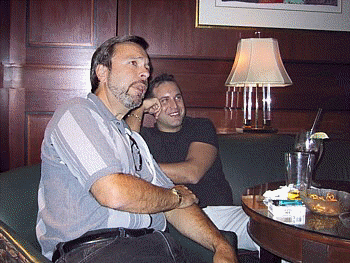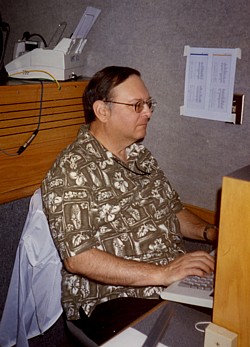Threads: End of a Century
|
Letters
written by me, updated November 2006 |
|
Background: This thread describes my television activites around the turn of the millenium. Another thread, Now An Orphan, details non-work-related experiences from that period, including the death of my father. In 1999, I was traveling all over the eastern half of the country. During the summer, I was the graphics operator for a weekly national baseball telecast on Fox Sports Net. (This became two games a week in 2000.) During the fall, I did graphics for Conference USA college football games on FSN. But the 2000 season was our last for football. Our agreement with the conference expired, and they signed a new deal with ESPN. And the 2001 season was our last for baseball. Fox sold to ESPN its national major league cable rights. It was part of a package deal with Disney that also resulted in the Fox Family Channel becoming the ABC Family Channel. Thus it was that after September 2001, I traveled a lot less than before. I was free to stay at home and work FSN Pittsburgh telecasts of the Pirates and Penguins, as well as local college games. This schedule has proven much less stressful. |
Tuesday, June 8, 1999
My father, whose health had gradually been declining throughout the decade, died on March 18 at the age of 89 at his home in Richwood, Ohio.
So now this "only child" has become an orphan.
Settling the estate is not difficult, since I'm the executor and sole beneficiary. But I do have to dispose of the house in Richwood and its furnishings.
Now, however, it's time to get back to my regular summer activity: baseball telecasts. I'll be in Cleveland Thursday for the Brewers-Indians game on Fox Sports Net.
|
The
NFL's new Cleveland Browns began play as an expansion team in
1999. Ned Tate, my director on Conference USA football on
autumn week Along with Ed Warren, I took the "look" that WKYC had created and developed it into a workable system. We televised a game at Tampa on August 14, the opening of the new Cleveland Browns Stadium on August 21, another game in Cleveland on August 28, and a game in Philadelphia on September 2. Then it was off to college football on Fox Sports Net. Below, our Conference USA television crew pauses for a team photo during our tour of Southern colleges. The picture was arranged by our technical producer, Mississippi's Brett Smith. (Or, as the local cameramen called him, "Brayett" Smith.)
Kneeling, left to right: Johnathan Evans, Lyndsay Polette, Brett Smith, Tim Record, Dave Kennedy, Tom Thomas, play-by-play announcer Paul Kennedy. Standing, left to right: unknown, Gary Nicholas, Lenny Vangilder, analyst Trevor Matich, Ned Tate, sideline reporter Lewis Johnson, Bob Fortenberry, unknown, Mitch Rubenstein, Tom Huet. |
Friday, December 10, 1999
Tom Thomas here, with a note for your edification:
You've probably noticed the amazon.com commercials featuring a chorus of middle-aged men in sweaters, standing on risers in a studio with fake snow and reverb and accordion accompaniment and the words crudely superimposed on the screen.
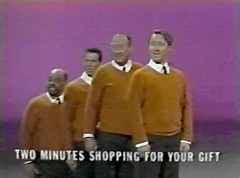
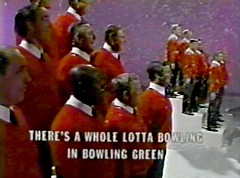
|
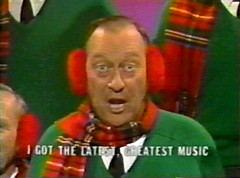

You may not know that this is a parody of an NBC-TV series of almost 40 years ago, "Sing Along with Mitch." According to a TV Guide history book, it aired from 8:30 to 9:30 on Friday nights in the 1962 season. And it was very much like these commercials, even to the rather flat low-contrast look of the RCA color cameras of the time.
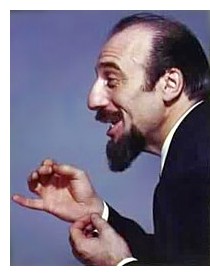 As
I recall, Mitch Miller was an executive at a recording company —
probably Columbia — who put out a series of sing-along albums
in the late fifties featuring old favorites with this sound.
For some reason, our family had a 45-rpm single of "The Yellow
Rose of Texas."
As
I recall, Mitch Miller was an executive at a recording company —
probably Columbia — who put out a series of sing-along albums
in the late fifties featuring old favorites with this sound.
For some reason, our family had a 45-rpm single of "The Yellow
Rose of Texas."
Then Mitch took the concept to television. He was a fiftyish guy with a goatee and a somewhat maniacal grin who introduced the show standing in front of the chorus, facing the camera with his back to the singers and directing the audience by beating time with both elbows stuck out.
But most of the time he stayed out of the way, and most of the show featured the singers not on risers but in staged settings, like around a campfire for a medley of cowboy songs. There were a number of soloists, too; I remember a teenaged Leslie Uggams, in an era when black performers were rare.
At the end of the show, the men sang the following — I have no idea why — to the tune of "The Stars and Stripes Forever":
Be kind to your web-footed friends,
For a duck may be somebody's mother.
Be kind to your friends in the swamp
Where the weather is very, very dahmp.
Now you may think that this is the end,
Well, it is!
Wednesday, December 22, 1999
I was on unemployment for about five months in 1980. I took the state of Pennsylvania up on its offer to give me a couple hundred dollars a week while I was looking for a job. The downside was that I had to stand in line each week to report on my lack of progress.
Actually, I've had only three full-time jobs in my life. All three fizzled because of too much red ink. I quit a dying job in Marion, Ohio, in 1974 for a better one in Washington, PA. That second position was phased out in 1980 by mutual agreement, with plenty of notice. My third job ended with the 1987 bankruptcy of the company I was working for, but by that time I was doing a lot of free-lance work, and since then I've been self-employed. Can't be fired, can't collect from the state.
Monday, January 3, 2000
A Y2K glitch on the Infinit:
Sunday night, I was on Classic Video's Galaxy truck with 9.00 software.
The "Set Date" function had properly rolled over from 1999 to 2000, but the "Disk Status" utility had apparently rolled over from year 99 to year 100. Existing directories were labeled with dates like 12/13/99, while those that I created on Sunday had the date 01/02/100.
As far as I could tell, though, this had no consequences. Just an oddity.
Wednesday, February 23, 2000
I got a call this afternoon from Sunnie Pulvers at Fox Sports Net in L.A. She says that Infinit operator Kenny Breitstein is cutting back this season because of a new baby.
On Baseball Thursdays last season, Kenny worked the western Fox Sports Net game while I was doing the eastern game, and he also did the Saturday game on FX. This year, Thursdays will be the same, but they want me to be the operator on Saturdays instead of Kenny.
All of this is still up in the air. Sunnie will talk with executive producer Larry Meyers when he gets back from Japan.
Friday, February 25, 2000
Larry Meyers called me this evening to talk in general terms about the schedule. One of the things he mentioned was that in a week where Kenny Breitstein's Thursday game was close to home in California, Kenny might be willing to travel away from home that Saturday and do the FX game that week as well.
As I look at the schedule, it might be good for both of us to have him do that. Consider the following 10 weeks . . . .
Of course, this affects the goal of keeping the Saturday crew together as much as possible. But neither one of us was going to be able to do all the Saturday games. You and I discussed a schedule that would have 17 Saturdays for me and 9 for Kenny. Above, I've suggested six Saturdays that might be switched, leaving 11 for me and 15 for him. The proportions aren't that much different. And on average, an FX game that I give up means two games that I probably will gain on Fox Sports Net Pittsburgh. So if you want to do something like this, I would not object. And if you want me to work as many Saturday FX games as I can, I'll do that too.
|
|
Tuesday, April 11, 2000: John Wrobel and Jerry Schad prepare for our final season of Pirates telecasts at Three Rivers Stadium. (The stadium would be replaced by PNC Park the following year.) |
|
|
Inside the truck, audio engineer Rick Kubia tries to get the Fox Box to produce its characteristic whooshing noises. |
|
|
Later, the Box is operated by Dirk Kruger, who clicks his mouse to register each ball, strike, hit, run, and so on. |
Wednesday, April 26, 2000
Well, I'm impressed. I always thought that animation took months to prepare, but South Park tonight had an episode based on the Elian Gonzalez story that must have been created in about 90 hours.
Much of the episode might have been written earlier, as a take-off on Cirque de Soleil, but at least ten minutes had to have been prepared from scratch starting about Sunday. It featured Janet Reno (disguised as the Easter Bunny) leading federal agents liberating foreign kids to return them to their Romanian father.
|
Later, there was a scene where the American host family went to the gates of a military base to try to see the kids again. And along the way, there were two scenes re-enacting the famous photo [right] of the armed agent finding a kid and an adult cowering in the closet. The second time, his finger was not off the trigger. |
|
Outstanding job, South Park!
|
There were five simultaneous TV productions of a hockey game in Pittsburgh on Thursday, May 4, 2000. Each team had its own broadcast crew, plus a national broadcast, plus two national broadcasts for Canada (English and French). The game was Game 4 of the playoff series between the Flyers and the Penguins. I was working on Brian Cooper's feed going to Philadelphia. Contrary to our usual procedure, we came in the day before to get everything ready on a "set day." Then on game day, we came in unusually early, at 10:00 in the morning. When the game was finally played that night, it was tied at the end of regulation, so they played overtime until somebody scored. Nobody did. Someone brought me a piece of pizza at 12:20 am. Finally, twelve minutes into the fifth overtime, the winning goal was scored at 2:35 am. Then we had to produce a postgame show that finally signed off at 3:16 am. Following that, we had to put the equipment away. When we finished at 5:30 am, some members of the crew had worked a 19½-hour day. That's a lot of overtime. Including the set day, I noted, "we're going to end up billing about four times as much as we would for a normal hockey telecast." I got home at 6:00 am Friday, took a two-hour nap, and then had to get ready to drive to Cincinnati for a baseball telecast on Saturday. |
Monday, May 8, 2000
Yes, we did see the extra pages of the Elias fax. And since Mitch Rubenstein had not gotten the e-mail about it, we all tried to figure out what these tables meant. No one could, so when Mitch talked to Peter Hirdt on the phone, he asked him what they were. Then they made sense.
E-mail from Peter at Elias Sports Bureau:
"Since the new 0-for graphics require updated batting averages after each at-bat throughout the game, these 'Batting Average Update Grids' are designed to simplify that process and make it as error-free as possible."
GALARRAGA (26-for-89)
|
0H |
1H |
2H |
3H |
4H |
5H |
|
|
0AB |
.292 |
|||||
|
1AB |
.289 |
.300 |
||||
|
2AB |
.286 |
.297 |
.308 |
|||
|
3AB |
.283 |
.293 |
.304 |
.315 |
||
|
4AB |
.280 |
.290 |
.301 |
.312 |
.323 |
|
|
5AB |
.277 |
.287 |
.298 |
.309 |
.319 |
.330 |
Explanation: Andres Galarraga comes into today's game batting .292. If at some point he has one hit (1H) in three at-bats (3AB), his average at that point would be .293.
I recall having dreamed up charts like these around 1963, when I was in high school and kept the "shot chart" for the basketball team. At the end of each quarter, I'd add up the baskets and attempts, and use long division to get the shooting percentage.
Once the coach jokingly said that he wanted running percentages, continuously updated during the game. Now this was several years before the hand-held calculator was invented, and it would have been awkward to use a slide rule on the bench, so I wondered how such a thing could be accomplished if we really wanted to do it.
I decided that a pre-calculated table like these would do the trick. Just circle the most recent percentage. If the team missed a shot, move down and circle that number; if they made one, move diagonally down and to the right and circle that number.
Glad to see that Elias has caught up with my 1963 technology.
Friday, June 9, 2000
Anne McCourt of Pittsburgh Crewing Company called on Wednesday, May 31, 2000, to book me for a Steelers preseason game on August 5 against the Miami Dolphins. I then talked on Tuesday, June 6, to Snuffy Smith about some of the details.
Tom Martin from Florida will be doing Infinit for most of the Dolphins preseason games, but not this first one. He will explain the disks to me.
Ted Beam from Altoona will be my coordinator, and John Grohol and Charlie Fisher will also be there, just like in 1985-1992 [when Snuffy had us all working Steelers preseason games for Pittsburgh's WTAE amd WPXI]. The truck will be F&F's "GPX."
Park and power on Friday, August 4, will be around 10:00 am. I'll be arriving from Baseball Thursday, currently scheduled for Toronto on August 3; it's okay if I arrive at Three Rivers around noon. Game time is 7:30 pm Saturday, August 5.
Monday, July 3, 2000
|
In Texas on Saturday, Mark Alsmeyer told me that our game on Thursday, July 13, has been changed: instead of the New York Mets at the Boston Red Sox, we're now going to do the St. Louis Cardinals at the Chicago White Sox. That would be the same two teams that we're already scheduled to televise two days later, on Saturday, July 15. If Mark's information is correct, I would stay in Chicago for three nights (Thursday, Friday, and Saturday). |
|
Tuesday, July 18, 2000
Tomorrow I'll head to Houston for my first visit to the new baseball stadium, Enron Field. And at the end of next week, I'll be in Canton to work the NFL Hall of Fame induction ceremony.

The 30-year history of Three Rivers Stadium in Pittsburgh came to an end with the final games in September 2000. Our TV crew posed in the stands for a farewell picture.
|
I'm the guy in the old-fashioned Pirates cap. As best as I can recall, that cap came from a game I attended there with my parents in 1977. |
|
|
|
When our Conference USA football crew was in Memphis, we always went out for dinner the night before the game at a certain downtown restaurant called Rendez-Vous. Associate producer Gary Nicholas came prepared.
|
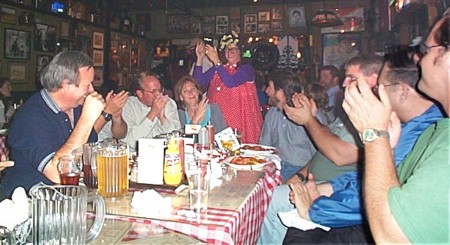
October 6, 2000, left to right: "Little Bob" (YES Productions), Brett Smith (technical producer), Midge Smith, Nelli the clown, Dave Kennedy (engineer in charge), Tom Carroll (technical director), Tom Thomas (Infinit, in blue jacket), Jerry Aneskievich (FOX Box).
|
|
Barbecued shrimp and ribs were on the menu. Our audio man, Tim "Toast" Record, took this shot of statistician Lenny Vangilder's plate afterwards. |
|
|
Some crew members, like Frank here, found the big meal somniferous. |
|
|
Clockwise from Jerry in green shirt: "Toast," Guy Rose (camera), unknown wearing glasses, Ned Tate (director), "Little Bob" (facing away), Bob Fortenberry (maintenance), Brett (waving), Midge, Dave, Tom Carroll, Tom Thomas. |
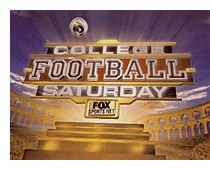
Wednesday, October 11, 2000
For a handful of Southern Miss players, full-screen bios are in the 1100s, and row records are in the 2100s. Stats can be found in the 300s, 500s, 700s, etc.; Mitch Rubenstein has the exact numbers.
Lower thirds that Mitch will ask for include two-liners (2702), "Zagers" (2704 with extra rows added as needed), and "Black-Whites" (2769). These addresses are for the visitors; add 100 for the home team.
Los Angeles provided us with two sets of lower-third stats shells for players, but we created a third set. They're at addresses 3760-3796 for the visitors, 3860-3896 for the home team. The last two digits are given in blue near the center of my single page of addresses. "Yr" means that there's a white "this season" tab above the player's name. "Hd" means that there's a place for the player's head shot. So if we were going to do in-game stats for a Tulane running back whose head shot is available, we'd start with shell 3881.
Tuesday, October 17, 2000
I'm a little late replying, but September and April are my busy months: baseball is being televised along with another sport (in September college football, in April hockey). Plus we have extra college football this year. Tomorrow I'll be in Louisville to set up for a Thursday-night game, and from there, we go to West Point for a Saturday-afternoon Army game.
Thursday, November 9, 2000
To Pat Heraty:
The headshots that I received on a Jaz disk were the same ones that I already had from September, with only two additions: Fresno State third-string offensive tackle Dejon Kelly and TCU long snapper Brian Edmondson. I have no idea why they picked those two.
I still need the heads of three players who have joined the starting lineup since September: Fresno State's Bernard Berrian (leading the team in receiving yards) and Tierre Sams (leading the team in interceptions), plus TCU cornerback Kenneth Hilliard. Hopefully we can grab those starters from tape Saturday morning. If we have time, we could also use TCU's new punter if his headshot exists, plus as many as seven other minor players that we probably won't worry about.
Other than that, we're in good shape. Lenny, I'll have some more info for you within the hour.
Friday, January 5, 2001
Public television station managers would have to feel strongly about their profession. Their stations usually have a mission to a small, underserved group, whether it's the Inuit in Alaska or the arts community here in Pittsburgh, but they don't get a lot of respect in the broadcast industry. I remember an article in a trade magazine that discussed how various networks were handling a broadcasting issue; it named NBC, CBS, ABC, Fox, The WB, UPN, PAX Net, Univision, Telemundo, but never got around to PBS.
And their biggest problem is always raising money. Until WQED-TV in Pittsburgh started a nightly news discussion show last year, budgets had been cut back to the point where the station produced very little local programming except for pledge breaks, the twenty-minute on-air pleas for viewer contributions. It seemed as though pledge periods (or "beg-athons") were the sole reason for the station's existence. Managing under those conditions would require dedication.
Thursday, February 15, 2001
The crewing company for Fox Sports Net Pittsburgh would like to know, by next week, my availability for specific dates during the baseball season. Are you in a position to let me know what dates you would like me to work for you on Fox Family Channel and FX national baseball telecasts?
 The
following would be my preferences, all else being equal.
The
following would be my preferences, all else being equal.
I can work on any and all Thursdays. Pittsburgh is planning to telecast home games on only two Thursdays, May 17 and August 9; if I don't work every week for Fox Family Channel, those two dates would be my first choice of weeks to miss.
Pittsburgh is telecasting most Saturdays when the Pirates are in town, so if possible, I'd like to schedule FX games for only those weekends when the Pirates are not in town.
Tuesday, March 6, 2001
Weather permitting, and I think it will, I'm off later this week to Chicago for a women's basketball tournament. Then, two weeks later, I'm in Minneapolis for the finals of the NCAA women's hockey tournament, the "Frozen Four." I didn't even know there was such a thing, but apparently the good teams are either from the Minnesota area or the Ivy League (Dartmouth, Harvard, Brown).
|
At the inaugural Women's Frozen Four on March 23 and 25, the University of Minnesota-Duluth's sports information officer was quite helpful to us on the TV graphics crew. She was also the cutest "Ira" ever, although she told us in her Finnish accent that we should call her Mimo. On my day off, I visited the Mall of America and explored downtown St. Paul, locating some landmarks including the Fitzgerald Theater. |
|
The week after that, spring arrives as the Pittsburgh Pirates open their new ballpark with an exhibition against the Mets on March 31. Around here, we can't wait!
Thursday, March 8, 2001
A comment on Rob Owen's March 8 column "Advertising-coverage deals sell out a station's ethics":
Over-eager account executives can indeed cause problems. Sometimes, to close a deal with a potential advertiser, they'll throw in bonuses (typically promising extra mentions within programs), and then it's up to the rest of the staff to make good on those promises to the extent that they can. If what's promised is news coverage of the advertiser's activities, we have a major challenge to journalistic ethics.
Suppose, though, that a news story were mandated not by a contract from the sales department but by a memo from management. For example, KDKA might instruct its journalists to give news coverage to the Children's Hospital fund drive (a station-sponsored project) or to "Survivor" (a CBS series). Would that pose an equal ethical problem?
Wednesday, March 21, 2001
I used my computer to tabulate the most popular first and last names among 1,776 baseball players at spring training 2001:
|
76 Mike/Michael |
16 Johnson |
|
39 John/Jon/Johnny/Johan/Jonathan |
13 Rodriguez |
|
38 Chris |
12 Perez |
|
37 Dave/David |
12 Williams |
|
36 Mark/Marc/Marcus |
12 Garcia |
|
36 Brian |
11 Hernandez |
|
35 Jason |
11 Wilson |
|
34 Scott |
10 Martinez |
|
31 Jeff/Jeffrey |
10 Smith |
|
31 Matt |
9 Gonzalez |
The player with the most popular name, Mike Johnson, is a righthanded pitcher in the Montreal organization.
Wednesday, April 11, 2001
In reply to your e-mail of last Friday, I'm keeping very busy, thank you. That's why it's taken me five days to answer. Yesterday was my only non-working, non-traveling day between April 3 and April 24.
|
|
Monday, August 6, 2001 "KD Box": This is a simple "Fox Box" designed to be run from a second Infinit. [Here are two of the proposed designs for Steelers preseason games.] The game clock is totally separate; the stadium scoreboard will be shot with a camera and the clock will be inserted lower right, according to our plan. |
|
Although Ned Tate of Cleveland, Ohio (foreground), had been my director for many football games, we were not going to be televising college football in the fall of 2001 because FSN no longer owned the Conference USA rights. |
|
But my coordinator Mitch Rubenstein (background) and I were in Cleveland for a baseball telecast that August, and Ned stopped by our hotel to catch up.
|
|
Here's another picture from about that time. That's me at the Infinit keyboard in NMT's mobile unit A21 for a Pirates baseball telecast. Someone on the crew had decreed that Hawaiian shirts were to be worn on Fridays, and I happened to have this one from my trip to Maui 16 years before. |
Thursday, October 4, 2001
My next baseball game was scheduled to be on Tuesday, September 11, in Pittsburgh. That morning I turned on a TV set to program my VCR and saw a picture of a damaged building with the graphic, "Breaking News: Airplane crashes into World Trade Center tower." I was watching when a second plane hit the second tower, although it wasn't clear for a few seconds what was going on (there was some kind of large aircraft to the right of the towers, followed by a fiery explosion to the left). By the time to leave for the ballpark at 10:30 am, the towers had fallen, the Pentagon had been hit, and there were reports of the crash of a fourth plane.
I knew there was a good chance that the game would be cancelled, especially since the visiting team was the New York Mets; but the official word had not come, so I went to where I was supposed to be. Meanwhile, most of the people who worked in downtown Pittsburgh were being sent home. Only four of us showed up outside PNC Park at the scheduled time. A quick cell-phone call confirmed that the game had just been called off, so we left.
Because the two Mets telecasts were cancelled on short notice, we got paid anyway. Most of us donated the money to a Salvation Army relief fund that one of our fellow freelancers, Joe Ferlic, quickly set up for us. It was the least we could do; we got the money back anyway when the games were rescheduled.
I was supposed to fly to Minneapolis on Friday, September 14, for a weekend series, just as the airlines were beginning to resume service. It was not until Thursday afternoon that the weekend games were called off and I knew I wouldn't have to go. As it turned out, the flight for which I had been scheduled on Friday morning was cancelled anyway.
But since then, things have more or less returned to normal. I went to New York for the last Saturday's Orioles-Yankees telecast; the plane was mostly empty going in on Friday, but almost full coming back on Sunday. The pedestrians in crowded Times Square, the subway riders after the game, all seemed to be going about their usual activities, but without "the effervescence, the swagger, the loudness that so characterized our pre-Sept. 11 lives," as one columnist put it.
Our analyst, former Met Keith Hernandez, was willing to work in New York but was afraid to fly to Houston for an upcoming game. Among the guests in our hotel were the entourage of a Puerto Rican boxer whose fight at Madison Square Garden had been delayed for two weeks, as well as several FEMA workers, identified by their blue and gold jackets.
Life went on, but nothing was quite the same, nor maybe ever will be.
But then, it never is completely the same, is it?
Sunday, Nov. 11, 2001
So you're in Syracuse for, like, a week. Yesterday being homecoming there, I took advantage of the Internet to check in with a webcam that looks out over the Quad. It's located near the opposite corner of the Dome from where the TV trucks park: in the old library, where some of my classes met years ago.
Folks were unloading stuff from a couple of white vans, while others were running around playing Frisbee or throwing footballs. In the fourth quarter, the fans started to trickle out of the Dome, but most apparently stayed until the game was over (at least the fraction who were heading past my vantage point).
Even this low-quality picture gave me a feeling of being back on campus. If the bandwidth were available, it would be interesting to provide similar video in broadcast quality. Imagine a hi-def "virtual window" where we aging baby boomers could sit for hours and watch the crowds go by, say on Fifth Avenue or at Venice Beach or outside Wrigley Field.
Friday, December 14, 2001
Perhaps it's been colder where you are, but we've had an extremely mild autumn in this part of the country. Winter will probably arrive in January. However, I won't have to shovel Pennsylvania snow for long. I'm leaving on January 29 for four weeks in Utah.
This will be my third Olympic Games, after Seoul 1988 and Atlanta 1996. I'm scheduled to be working in the International Broadcast Center at the convention center in downtown Salt Lake City.
|
How did that work out? Click here for my TV experiences, or here for my Salt Lake City experiences. |
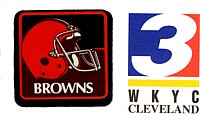 ends,
had a full-time job at WKYC-TV. That station owned the TV
rights to four preseason Browns games, and Ned hired me to be the
Infinit operator.
ends,
had a full-time job at WKYC-TV. That station owned the TV
rights to four preseason Browns games, and Ned hired me to be the
Infinit operator.
